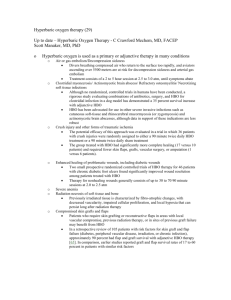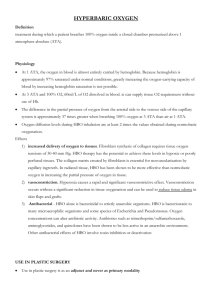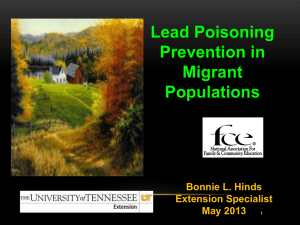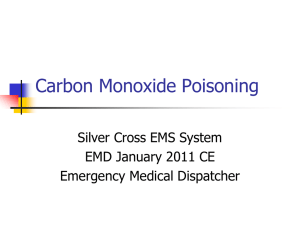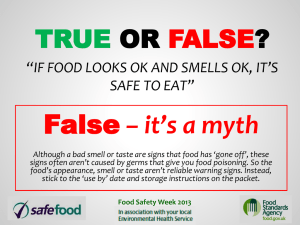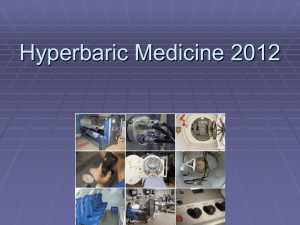antidotesjbcole1 - Med Student Workshops
advertisement
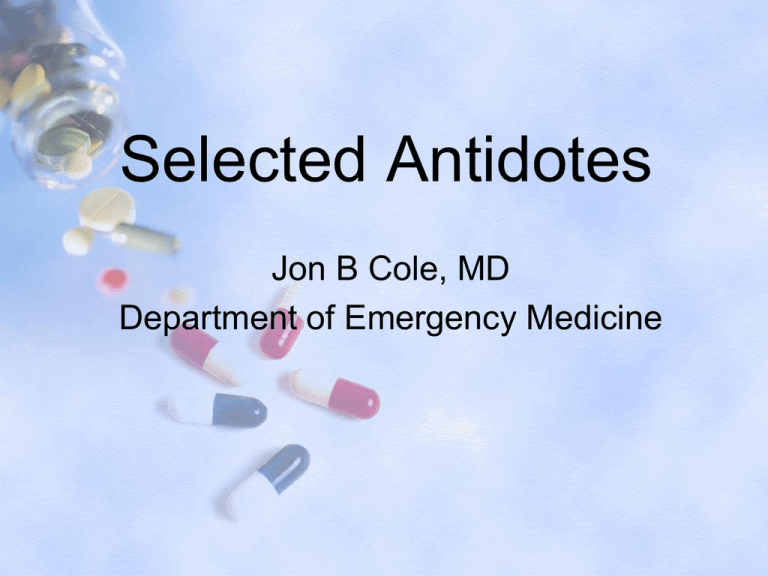
Selected Antidotes Jon B Cole, MD Department of Emergency Medicine Objectives • Discuss the treatment of carbon monoxide poisoning, including hyperbaric oxygen • Discuss the treatment of organophosphate poisoning, including the value of oxime treatment • Review old and new treatments of cyanide toxicity • Review the indications and uses of some classic antidotes Background • Antidote: any substance which can counteract a form of poisoning. • Derived from the Greek “anti didonai,” which literally translates as “given against.” • Different mechanisms: – – – – – Animal antibodies Enzyme inhibitors Cofactor Competitive inhibition “Universal” antidotes Oxygen (O2) Oxygen (O2) • The treatment of choice for carbon monoxide (CO) poisoning • Normobaric (NBO) vs. Hyperbaric (HBO) • HBO also used to treat: – – – – – – – – Cyanide (CN) Hydrogen sulfide (H2S) Carbon tetrachloride (CCl4) Methylene chloride (Ch2Cl2) Methemoglobinemia Decompression sickness Air embolism Necrotizing fasciitis Carbon Monoxide (CO) • Binds hemoglobin with 230-270 times the affinity of oxygen • Also binds myoglobin, cytochrome P450, and cytochrome aa3 – Note: CYP450 is named after the peak absorption of light at 450nm when the enzyme is 50% saturated with CO • Transforms the hemoglobin binding curve from a sigmoid to an asymptotic shape Carboxyhemogloin (COHb) Hyperbaric Oxygen (HBO) • Physiologic goal is elevation of partial pressure of O2 • Outcome goal is restoration/preservation of normal CNS function as well as reduction in mortality • Much controversy exists regarding the benefit of HBO – 6 prospective studies have been done to date, all with mixed results • 2 of these studies are fairly recent 60 min HBO 2.5atm 3-4 hours 100% NBO Room Air Carboxyhemoblobin – half-life 20 min HBO – Scheinkestel et al (AUS) • 191 CO-poisoned patients of different severity • High flow O2 (for 3 or 6 days) vs. HBO (3.0 ATA for 60 minutes daily) • Outcome measured was neuropsychiatric testing 1 month after treatment • No benefit shown, but… HBO – Scheinkestel et al (AUS) • Controversies: – 69% of cases were suicide attempts – 50% of patients co-ingested EtOH or other drugs – Both the NBO and HBO regimens deviated from standard regimens and were potentially toxic – Many patients had active depression or CNSaffecting drugs on board at 1 month during their neuro-psych testing – Only 46% of the patients completed the follow-up test HBO – Weaver, et al (USA) • 152 patients, stratified by age (<40 or >40), time to end of CO exposure, start time of treatment (< 6 hrs or > 6hrs), hx of LOC. • Patients treated 3 times at 6-12 hr intervals in a monoplace chamber • Outcomes measured by CO poisoning questionnaires, functional outcome evaluations, neuropsychological test battery given at 2 weeks, 6 weeks, 6 months, and 12 months HBO – Weaver, et al (USA) • NBO group did have a higher incidence of cerebellar dysfunction, but this was accounted for • HBO group had a lower incidence of cognitive sequelae • Risk factors for which HBO therapy was recommended were: – – – – LOC COHb ≥ 25% Age 50 ≥ years Base excess ≤ 2mEq/L • Patients without any of these characteristics did not have improved outcomes HBO - Indications • Definite: – – – – – – – AMS/Abnormal Neuro Exam LOC or near-syncope Coma Hypotension at any time MI “Prolonged” exposure Pregnancy and COHb ≥ 15% • Relative: – – – – Persistent Neurologic Sxs (including HA or dizzy) after 4hrs NBO Persistent acidosis Concurrent thermal or chemical burns Pregnancy regardless of COHb level HBO - Contraindications • Paraquat poisoning • General HBO contraindications (relative) – Middle ear surgery – Thoracic surgery – Untreated pneumothorax – Seizure disorder – Severe sinusitis HCMC Hyperbaric Chamber HCMC HBO Indications (non-pregnant) • LOC • COHb ≥ 40% • “Serious” toxicity including: – – – – – – Lethargy, confusion or disorientation on arrival to med facility Hx of seizures Focal neuro deficit Ischemic chest pain New dysrhythmias or ECG changes Hypotension • COHb ≥ 25% plus: – – – – Hx of CAD Age ≥ 60 yrs or ≤ 2 years HGB ≤ 10 Exposure duration ≥ 2 hours HCMC HBO Indications (pregnant) • • • • Patients meeting any of the previous indications COHb ≥ 20% Exposure duration ≥ 5 hrs Any signs of fetal distress HCMC HBO protocol • Non-pregnant – – – – 100% O2 by non-rebreather mask until HBO 100% O2 at 2.4 ATA for 90 min 100% O2 by non-rebreather until pt without sxs and COHb ≤ 3 Dispo as appropriate, f/u w/ Neurology in 1 month • Pregnant (as above, plus) – – – – Check for fetal distress prior to HBO L&D fetal monitoring if gestation ≥ 28 weeks Dispo as appropriate, same Neurology follow-up F/u w/ OB/GYN in 1 week N-Acetylcysteine (NAC) • The mainstay of treatment for acetaminophen (APAP) overdose • Other uses include treatment of: – – – – – – – Chloroform CCl4 1,2-dicloropropane Acrylonitrile Doxorubicin Cyclophosphamide Radiographic contrast exposure APAP metabolism Glutathione (GSH) metabolism NAC • Provides a substrate for sulfation • Regenerates glutathione (reduced form - GSH) • GSH reduces NAPQI, allowing it to be cleared via the kidneys APAP and NAC metabolism • NAC allows safe metabolism of the directly hepatotoxic metabolite NAPQI. • NAC is itself an antioxidant, which may be more useful in latepresenting overdoses Rumack-Matthew Nomogram • Published 1975 • Based on a retrospective analysis of previous APAP overdoses and their clinical outcomes • Original line at 200mcg/mL, but moved to 150 at urging of FDA • 200 still the treatment threshold in Europe NAC – additional indications • Consider NAC if patients are on any CYP 2E1 inducers – Isoniazid – Chronic alcohol use/abuse • Signs of liver toxicity past 24 hours and still-measurable APAP level • Note: pregnancy is NOT a contraindication NAC – oral vs. IV NAC - oral • Advantages: – reduced anaphylactoid reaction risk – Safer in asthmatics • Disadvantages: – Horrible smell – Vomiting common (may need antiemetics) – Dosing is over 72 hours • 140mg/kg load • 70mg/kg dose q 4 hrs thereafter for 17 does IV NAC - Acetadote® IV NAC - Acetadote® • Advantages: – Shorter treatment course – 21 hours • 150mg/kg loading dose over 1 hr (instead of 15 min) • 50mg/kg in 500mL D5W over 4 hrs • 100mg/kg in 1000mL D5W over 16 hrs – New dosing guidelines for < 40kg patients now available – Decreased GI effects – Actually studied in hepatic failure • Disadvantages: – Increased anaphylactoid reactions – More costly (debatable) – Difficult Peds dosing • Initial reports of hyponatremia from increased water infusion Allergic reactions – What to do • Stop the IV infusion immediately • Treat accordingly – Diphenhydramine, steroids, epi if indicated • Once the reaction resolves, infusion can be re-started • If the reaction persists or worsens, stop the IV infusion and either switch to oral or re-evaluate the need for NAC – Oral has been proven very safe in patients who have had severe reactions to the IV perparation Physostigmine (Antilirium®) • The antidote for anti-cholinergic toxicity • A carbamate that reversibly inhibitis cholinesterases in both the CNS and PNS • Derived from the plant Physostigma venenosum Balfour, from Nigeria Physostigmine • Originally used as a miotic agent to treat glaucoma, and in the treatment of myasthenia gravis • Also used as an antidote to atropine toxicity, and as an insecticide • Structure is tertiary amine (other “stigmines” are quaternary), which allows better CNS penetration. Tertiary vs. Quaternary Amines Physostigmine Neostigmine • Uncharged • Charged Physostigmine • Available only as an IV preparation • Dose: 1-2mg infused over at least 5 min (0.02mg/kg in peds). • Onset of action is within minutes • Dose can be repeated q 10-15 min • T1/2 is 16 minutes, but duration of action is usually much longer Physostigmine and TCA OD • Physostigmine was used often in the 1970s to treat undifferentiated delerium • Case report by Pentel in 1980 re: 2 patients who suffered asystole after receiving physostigmine for TCA overdoses • Since then the antidote has greatly fallen out of favor Physostigmine - Indications • Peripheral or Central anti-cholinergic manifestations without evidence of QRS or QTc prolongation, such as: – – – – – – Agitation Hypertheria Hallucinations Delerium Seizures coma • The patient to use this in is a known non-TCA anti-cholinergic overdose Physostigmine - contraindications • Definite contraindications: – Suspicion of TCA ingestion – Widened QRS on ECG • Relative contraindications: – – – – History of asthma Concomitant use of succinylcholine Parkinsonism AV block • Beware “evidence based medicine” such as uptodate.com Opioid Antagonists • Primarily μ-antagonists, some secondary antagonism of κ and δ receptors. • 3 options available: – naloxone (Narcan®) – nalmefene (Revex®) – naltrexone (Revia®) • The primary difference between the three drugs is their duration of action Opioid Antagonists • Naloxone – Duration of action 1-2 hours – Can be started as a drip – Re-assess for respiratory distress • Nalmefene – Duration of action up to 4 hours – More expensive • Naltrexone – Duration of action up to 24 hours – Oral preparation only Opioid Antagonists • Used primarily in the treatment of opioid overdose, though naloxone is used to treat other overdoses such as: – Clonidine – Ethanol – Benzodiazepines – Valproic acid – captopril • No major contraindications Opioid Antagonists - Structure Agonist Antagonist Naloxone Dosing • “Waking up” vs. withdrawal – different approaches • Usual dosing is to start low and titrate up – 0.4mg, then 2mg, then 10mg – If no response, consider another cause of coma • Remember, naloxone can be given via the endotraheal tube, but dosing should be 23x. Flumazenil (Romazicon®) • A competetive benzodiazepine receptor antagonist. • Unlike naloxone, flumazenil is NOT indicated as part of the “coma cocktail,” as it has potentially serious side-effects and minimal benefit Flumazenil • Flumazenil precipitates seizures in benzodiazepine dependent patients, and in patients with underlying seizure disorders – The “zero setpoint” of intrinsic CNS activity may be influenced by GABA activity and chronic benzo use • Flumazenil can also unmask dysrhythmias in patients who co-ingest pro-arryhthmic drugs Flumazenil - Indications • Known benzo ingestion in benzo-naïve patients, e.g. – Iatrogenic exposure – Toddler ingestion – Paradoxic benzo response • Postoperative or postprocedure sedation reversal • CNS depression from hepatic encephalopathy Flumazenil - dosing • Start with 0.2mg IV over 30 seconds (0.01mg/kg in children) • If no response, then 0.3mg over 30 seconds • If still no response give 0.5mg every 30 seconds up to 3 mg Atropine • A competetive anti-muscarinic drug that acts both centrally and peripherally • Derived from the plant Atropa belladonna • Similar to physostigmine it has a teritiary amine structure, whereas other anti-muscarinic drugs such as glycopyrrolate are quaternary amines Tertiary vs. Quaternary Amines Atropine Glycopyrrolate Atropine - Indications • • • • Organophosphate poisoning “Nerve Gases” Carbamate poisoning Bradycardia from: – Beta blockers – Calcium antagonists – Digitalis – Other AV node-blockers Atropine - Contraindications • All are relative – – – – – – – – – Angle-closure glaucoma Myasthenia gravis Obstructive uropathy Obstructive GI diseases (severe ulcerative colitis) Hypertension Thyrotoxicosis Tachyarrhythmias CAD Valvular disease Atropine Dosing in Organophosphates • Based on work by Eddelstein, et al, J Clin Tox, 2004 • Starting dose is 0.5-2mg, then doubling every 5 minutes until “endpoint” is achieved – Pediatric starting dose is 0.02mg/kg • Goal is “atropinization” – Clear chest on auscultation – Increased heart rate > 80 • Each poisoned patient may need as much as 75mg of atropine, so be prepared to mobilize stores Pralidoxime (2-PAM® or Protopam®) • Used in the treatment of organophosphate (OP) poisoning • OPs exert their effects by phosphrylating cholinesterases, inactivating them • Cholinestereases break down acetylcholine (ACh), so ACh builds up in synapses and causes a cholinergic or muscarinic crisis Pralidoxime Quaternary oxime Pralidoxime - mechanism • Bound (inactive) undergo one of three processes: – Endogenous hydrolysis and recovery (as with carbamates, such as physostigmine) – Reactivation by a strong nucleophile (e.g. 2-PAM) – “Aging,” which involves biochemical changes to the enzyme that result in permenant dysfunction • Oximes work to prevent aging by exerting a nucleophilic attack on the phosphate moiety, releasing it from the enzyme and preventing aging Pralidoxime • Believed to work synergistically with atropine • Can be used in severe carbamate poisonings • Some evidence the drug should be used within 48 hrs – by this time aging may be inevitable • A mainstay of OP poisoning treatment, but… Pralidoxime – benefit? • There is now evidence that oximes may not only not improve mortality, they may be harmful. – Buckley, et al (2005) Cochrane Database • Two published RCTs, one abstract RCT • Insufficient evidence for harm or benefit of oximes – Peter, et al (2006) Crit Care Med • Two published RCTs, 5 controlled trials • Oximes either ineffective or harmful – Rahimi, et al (2006) Human Exp Toxicol • Six clinical trials • Oximes are not effective and can be dangerous Pralidoxime • For now, it is the standard of care • Always use with atropine • Field Dosing – 600mg IM from the autoinjector, up to 3 doses • Hospital Dosing is – 1-2g IV over 15-30min as initial dose • 25-50mg/kg in children – Continuous infusion of 200-500mg/hr thereafter • 5-10mg/kg in children The Mark I Nerve Agent Antidote Kit • 600mg IM of pralidoxime • 2mg IM of atropine Treatment of cyanide (CN) • CN is toxic because it binds the ferric (Fe3+) ion in cytochrome oxidase, uncoupling oxidative phosphorylation and causing chemical asphyxia. • Treatment involves – creating other sources of Fe3+, – inducing the enzyme that clears CN, and – providing another oxidized ion (Co+) for the CN to bind with Nitrites • Nitrites (-NO2) oxidize the iron in hemoglobin from Fe2+ to Fe3+ to create methemoglobin • Since CN reversibly binds the Fe3+ in cytochrome oxidase, it now has a new competetive pool of Fe3+ to bind Amyl Nitrite • A volatile (and flammable) gas • Comes in 0.3mL ampules • Administered by breaking open the ampule and holding it in front of the patient’s mouth for 15 seconds on, then 15 seconds off, etc. • Should be discontinued as soon as an IV can be established • This is a stop-gap solution Sodium Nitrite • Comes in a 10mL vial, 300mg • Administered IV at 2.5-5mg/min • Should be followed immediately with IV sodium thisulfate Nitrites • Indications – Symptomatic cyanide poisoning – Hydrogen sulfide (H2S) poisoning < 30 min ago • Contraindications – Significant (>40%) pre-existing methemoglobinemia – Severe hypotension – Concomitant CO poisoning/smoke inhalation Sodium Thiosulfate (Na2S2O3) • This relatively non-toxic CN antidote works to regenerate the mitochondrial enzyme rhodanese. • Rhodanese metabolizes CN to thiocyante (SCN-) by using a unique sulfur bond on the enzyme known as a sulfane group • This is the only type of sulfur that reacts with CN Sodium Thiosulfate (Na2S2O3) • Comes in 50mL bottles containing 12.5 • Given IV as a bolus or over 10-30 min depending on severity of illness • No significant contraindications Nitrites and Thiosulfate - Summary Taylor Pharmaceuticals Cyanide Antidote Kit • 12 ampules of amyl nitrite • 2 ampules of sodium nitrite • 2 vials of sodium thiosulfate • Cost: $317.18 each hydroxycobalamin (Cyanokit®) • Hydroxycobalamin is a direct precursor to cyanocobalamin (a member of the vitamin B12 family) • FDA approved in 2007 • Very safe Hydroxycobalamin - metabolism Hydroxycobalamin Cyanocobalamin Hydroxycobalamin • Dosing: – 5g IV given over 15 minutes • Side effects: – Turns body fluids bright red within minutes • Interactions: – Do not administer in the same line as sodium thiosulfate, as they will bind each other rendering them both ineffective References • • • • • • • • • • Pentel, P, et al, “Asystole Complicating Physostigmine Treatment of Tricyclic Antidepressant Overdose,” Ann Emerg Med, Nov 1980, pp 588-590 Cocuzza, et al, “Inappropriate Use of Physostigmine in TCA Toxicity: An Online Medical Reference May Be Partially Responsible,” Clinical Toxicology, Vol 46, No 7, Aug 2008 Goldfrank, L, et al, “Goldfrank’s Toxicologic Emergencies,” McGraw-Hill, Mar 2006, pp 122, 544-549, 614-619, 794-797, 1112-1117, 1513-1518, 1519-1522, 1705-1711, 17251727, 1728-1730, 1731-1733 Dart, RC, “Medical Toxicology,” Ch. 5, “Antidote Stocking,” Lippincott, Wilkens, & William, December, 2003, pp 159-163 Weaver, LK, et al, “Hyperbaric Oxygen for Acute Carbon Monoxide Poisoning,” NEJM, Oct. 3, 2002, pp 1057-1067 Scheinkestel, CD, et al, “Hyperbaric or normobaric oxygen for acute carbon monoxide poisoning: a randomised controlled clinical trial,” Medical Journal of Australia, 1999, 170: 203-210 HCMC Guidelines for Treatment of Carbon Monoxide Poisoning, current as of August 2008 Olson, KR, et al, “Poisoning & Drug Overdose,” Lange Medical Books/McGraw-Hill, 2004, pp406-519 Cyanokit manufacturer’s package insert, current as of August 2008 Acetadote manufacturer’s package insert, current as of August 2008
